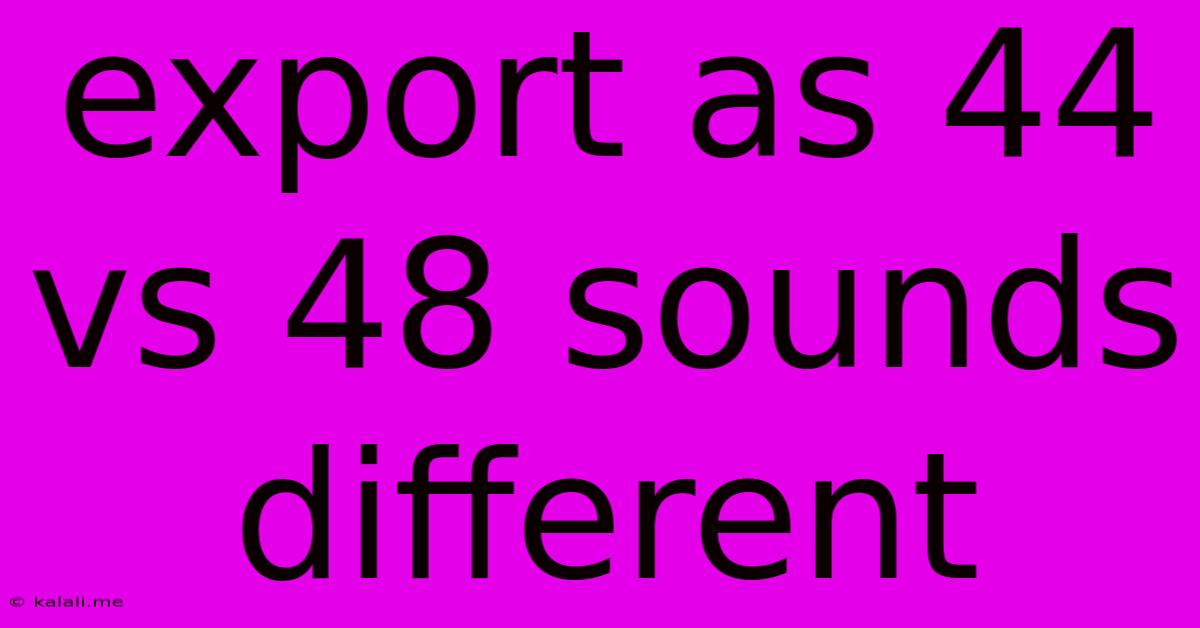Export As 44 Vs 48 Sounds Different
Kalali
Jun 03, 2025 · 3 min read

Table of Contents
Exporting Audio: Does 44.1kHz vs 48kHz Really Make a Difference?
Choosing between 44.1kHz and 48kHz sample rates when exporting your audio might seem like a minor detail, but it can actually impact your final product, especially for certain applications. This article dives deep into the differences between these two common sample rates, exploring when one might be preferred over the other and dispelling some common myths.
What are Sample Rates?
Simply put, the sample rate (measured in kilohertz, kHz) determines how many times per second your audio is "sampled"—measured and converted into digital data. A higher sample rate means more data points are captured per second, resulting in a more detailed representation of the original sound wave. 44.1kHz is the standard for audio CDs, while 48kHz is prevalent in professional audio and video production.
44.1kHz: The CD Standard
For years, 44.1kHz has been the industry standard for CDs and consumer audio. It offers excellent sound quality for most listeners and is widely compatible with almost all playback devices. The lower sample rate also results in smaller file sizes, making it convenient for distribution and storage.
48kHz: The Professional Standard
48kHz is the preferred sample rate in many professional audio and video workflows. Its higher sampling frequency allows for a slightly more accurate capture of high-frequency sounds, potentially resulting in a more detailed and nuanced sound. While the difference might be subtle to the average listener, professionals often appreciate the added headroom and precision. It’s also the standard for many professional digital audio workstations (DAWs) and video editing software.
So, Do They Really Sound Different?
The truth is, the difference between 44.1kHz and 48kHz is often subtle and difficult to discern for the average listener. Many blind listening tests have shown that most people cannot reliably distinguish between the two. The perceived difference often depends on factors like the quality of your speakers and headphones, the source material itself, and the listener's hearing acuity.
However, this doesn't mean the difference is nonexistent. In certain situations, particularly with high-frequency sounds or complex audio, a more discerning listener might perceive a slight improvement in clarity and detail with 48kHz.
When to Choose Which Sample Rate:
-
44.1kHz: Ideal for:
- CD mastering: This remains the standard for CD production.
- Web distribution: Smaller file sizes are beneficial for streaming and downloads.
- Situations where file size is a priority: This is crucial for users with limited storage or bandwidth.
-
48kHz: Ideal for:
- Professional audio and video production: The slight increase in fidelity can be beneficial in a professional setting.
- Projects requiring high-frequency accuracy: For instance, mastering high-resolution audio or recording instruments with extended high-frequency range.
- Maintaining compatibility within a professional workflow: Consistency is key when collaborating with others.
Beyond Sample Rate: Other Factors Affecting Audio Quality
Remember that sample rate is just one aspect of audio quality. Other crucial factors include:
- Bit depth: This determines the dynamic range and resolution of your audio. Higher bit depth (e.g., 24-bit) generally translates to better sound quality.
- Encoding: The codec you choose (e.g., WAV, MP3, AAC) significantly impacts the final file size and quality.
- Mastering: Proper mastering techniques are essential for achieving optimal sound quality, regardless of the sample rate.
Conclusion:
While the difference between 44.1kHz and 48kHz might be subtle for casual listeners, professionals often prefer 48kHz for its added precision and headroom. The best choice depends heavily on the intended use of your audio. However, focusing solely on the sample rate while neglecting other crucial aspects of audio production would be shortsighted. Prioritizing a robust workflow, high-quality recording techniques, and proper mastering will always yield significantly better results than simply choosing a higher sample rate.
Latest Posts
Latest Posts
-
Pro Tools Automition Track Shortcut Key
Jun 05, 2025
-
Can My Computer Play This Game
Jun 05, 2025
-
Why Roc Curve For Breast Cancer Has Only 1 Corner
Jun 05, 2025
-
Python Linear Programming Region Of Every Variable
Jun 05, 2025
-
Alpha Configuration Bonded To Beta Configuration
Jun 05, 2025
Related Post
Thank you for visiting our website which covers about Export As 44 Vs 48 Sounds Different . We hope the information provided has been useful to you. Feel free to contact us if you have any questions or need further assistance. See you next time and don't miss to bookmark.